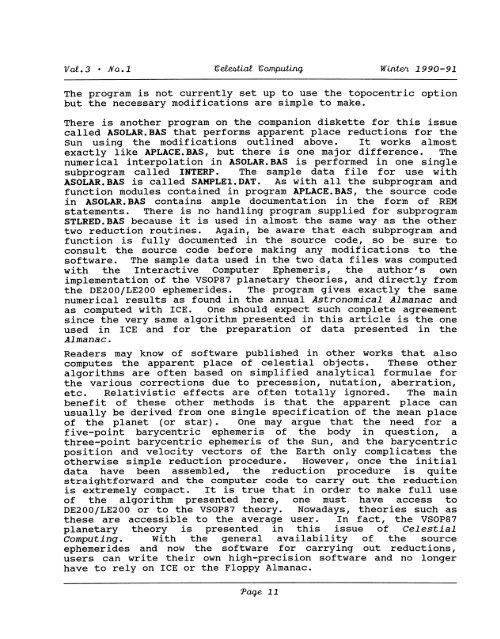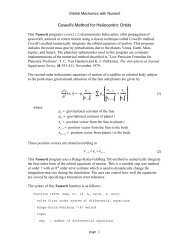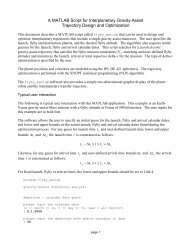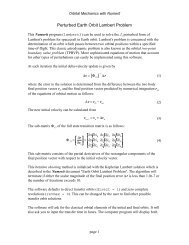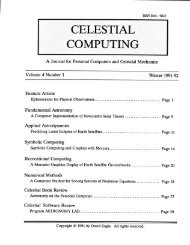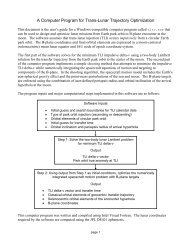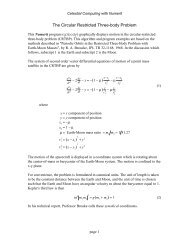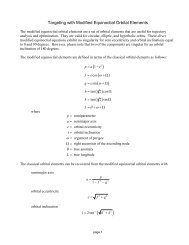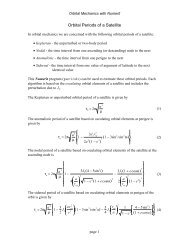CELESTIAL COMPUTING - Orbital and Celestial Mechanics Website
CELESTIAL COMPUTING - Orbital and Celestial Mechanics Website
CELESTIAL COMPUTING - Orbital and Celestial Mechanics Website
- No tags were found...
Create successful ePaper yourself
Turn your PDF publications into a flip-book with our unique Google optimized e-Paper software.
Vol.3 • Na.l %ete&tlal Gamputinq, Winten 1990-91The program is not currently set up to use the topocentric optionbut the necessary modifications are simple to make.There is another program on the companion diskette for this issuecalled ASOLAR.BAS that performs apparent place reductions for theSun using the modifications outlined above. It works almostexactly like APLACE.BAS, but there is one major difference. Thenumerical interpolation in ASOLAR.BAS is performed in one singlesubprogram called INTERP. The sample data file for use withASOLAR.BAS is called SAMPLE1.DAT. As with all the subprogram <strong>and</strong>function modules contained in program APLACE.BAS, the source codein ASOLAR.BAS contains ample documentation in the form of REMstatements. There is no h<strong>and</strong>ling program supplied for subprogramSTLRED.BAS because it is used in almost the same way as the othertwo reduction routines. Again, be aware that each subprogram <strong>and</strong>function is fully documented in the source code, so be sure toconsult the source code before making any modifications to thesoftware. The sample data used in the two data files was computedwith the Interactive Computer Ephemeris, the author's ownimplementation of the VSOP87 planetary theories, <strong>and</strong> directly fromthe DE200/LE200 ephemerides. The program gives exactly the samenumerical results as found in the annual Astronomical Almanac <strong>and</strong>as computed with ICE. One should expect such complete agreementsince the very same algorithm presented in this article is the oneused in ICE <strong>and</strong> for the preparation of data presented in theAlmanac.Readers may know of software published in other works that alsocomputes the apparent place of celestial objects. These otheralgorithms are often based on simplified analytical formulae forthe various corrections due to precession, nutation, aberration,etc. Relativistic effects are often totally ignored. The mainbenefit of these other methods is that the apparent place canusually be derived from one single specification of the mean placeof the planet (or star) . One may argue that the need for afive-point barycentric ephemeris of the body in question, athree-point barycentric ephemeris of the Sun, <strong>and</strong> the barycentricposition <strong>and</strong> velocity vectors of the Earth only complicates theotherwise simple reduction procedure. However, once the initialdata have been assembled, the reduction procedure is quitestraightforward <strong>and</strong> the computer code to carry out the reductionis extremely compact. It is true that in order to make full useof the algorithm presented here, one must have access toDE200/LE200 or to the VSOP87 theory. Nowadays, theories such asthese are accessible to the average user. In fact, the VSOP87planetary theory is presented in this issue of <strong>Celestial</strong>Computing. With the general availability of the sourceephemerides <strong>and</strong> now the software for carrying out reductions,users can write their own high-precision software <strong>and</strong> no longerhave to rely on ICE or the Floppy Almanac.11


